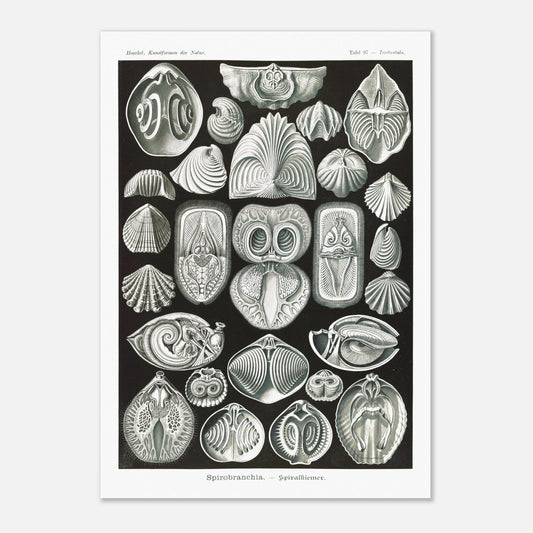Spirobranches - Old scientific engraving - Ernst Haeckel, Kunstformen der Natur
Spirobranches - Old scientific engraving - Ernst Haeckel, Kunstformen der Natur
Couldn't load pickup availability
Reproduction engraving of: Spirobranches
Original title Spirobranchia - Spiralkiemer
Terebratula Poster - Worms of the main class Brachiopods (Brachiopoda), Class Spirorbs (Spirobranchia)
Illustration from the book Kunstformen der Natur, which is a collection of artistic lithographs of natural sciences published by the German biologist Ernst Haeckel between 1899 and 1904.
This naturalistic illustration is part of an overall style inspired by Ernst Haeckel, which greatly influenced the emerging Art Nouveau movement at the beginning of the 20th century. This work, illustrating the impressive beauty and great diversity of the biological world, was complemented by a certain amount of scientific information, some excerpts of which are reproduced below.
This information is over 120 years old and some of it may be outdated!
Scientific classification:
Phylum of Vermiform Animals (Vermalia) Main class of Mouthworms (Prosopygia) Class of Spirobranchs (Spirobranchia) or Brachiopods (Brachiopoda)
Scientific notice (extract) accompanying the poster print of Spirobranchia - Spirobranches :
The diverse class Spirobranchia (Spirobranchia) includes a peculiar group of marine animals formerly classified as mollusks because of their bivalve shells resembling those of true bivalve mollusks (Acephala, see Table 55). However, this similarity is superficial; the two valves of bivalve mollusks meet laterally and are connected by a hinge on the back, similar to what is seen in mollusk-like crustaceans, such as barnacles (Cirripedia, see Table 57). In contrast, the two valves of spirobranchia lie above and below the fixed body; the smaller dorsal valve (Valva dorsalis) is flat and rests on the larger, more curved ventral valve (Valva ventralis). They can be 1 to 9 cm in size. The hinge (Cardo) that connects the two valves is at the posterior end. Typically, the ventral valve is attached to the seabed by a stalk. From the flat, spindle-shaped body that fills only the posterior half of the shell cavity, two thin mantle lobes emerge, separating the shell and bearing setae on the edge (Fig. 13). At the anterior end of the soft body is the mouth surrounded by a pair of characteristic large arms (Brachia). These arms are coiled in a spiral and bear numerous fine gill filaments on the outer edge of the spiral. The hollow gill slits are filled with blood on the inside and lined with motile cilia on the outside; they serve both for respiration and for creating a water current that carries food to the toothless mouth. The arms themselves are only slightly or not at all motile, often supported by a spiral column inside, also well preserved on fossil shells (Figs. 1-8, 14-18). The newer name "spirobranchs" is therefore more appropriate than the older name "footlamps." The closest relatives of these vermalians are not bivalve mollusks, but bryozoans (Bryozoa, see Table 23). The ciliated tentacles or sensory filaments of bryozoans correspond to the fine individual gill filaments of spirobranchs, and the two "arms" of the latter correspond to the two horseshoe-shaped arms of the bryozoan ventral valve carrier (see Table 23, Fig. 6-8). The juvenile larvae of spirobranchs are organized similarly to the zoophores of bryozoans. During early periods of Earth's history, spirobranchs played an important role; Their fossilized shells form large rock masses, with nearly 3,000 fossil species recorded, while fewer than 100 living species are known today.
Species present on the Spirobranches - Terebratula naturalist board :
- Dayia navicula
- Strophomena rhomboidalis
- Cyrtina heteroclita
- Spirifer gibbosus
- Rhynchonella nympha
- Rhynchonella eucharis
- Rhynchonella inaurita
- Rhynchonella psittacea
- Lingula anatina
- Terebratula flavescens
- Waldheimia australis
- Atrypa insolite
- Rhynchonella oblita
- Terebratulina serpentis
- Terebratulina murrayi
- Spirigerina concentrica
- Rhynchonella nigricans
- Nucleospira pisum
- Atrypa marginata
About this print
About this print
The layout and composition of this reproduction have been the subject of our greatest attention.
- Respect for the format of the original work: in order to faithfully transcribe the artist's intention, the work is not cropped/re-cut except in extreme cases (obvious imperfection, geometry problem, etc.) in which case the cropping will be as light as possible.
- The presence of white margins is sometimes necessary in order to present the work in a balanced manner.
- Each size offered has been specifically composed, therefore, the size of the white margins may vary from one print size to another. Remember to check this detail carefully!
- Print only, frame not included!
Features
Features
- Premium 200gsm matte white paper, durable and strong.
- Natural, smooth uncoated finish, silky to the touch
- FSC certified paper or equivalent certifications depending on regional availability.
- Each print is shipped in sturdy packaging, ensuring safe transport.
- Each print is printed and shipped on demand. No minimum order quantity is required.
Share !









We are listening to you
If you are looking for a specific composition, a particular layout, or any other customization need, our team is at your disposal and will do everything possible to meet your requests.
So don't hesitate to...




